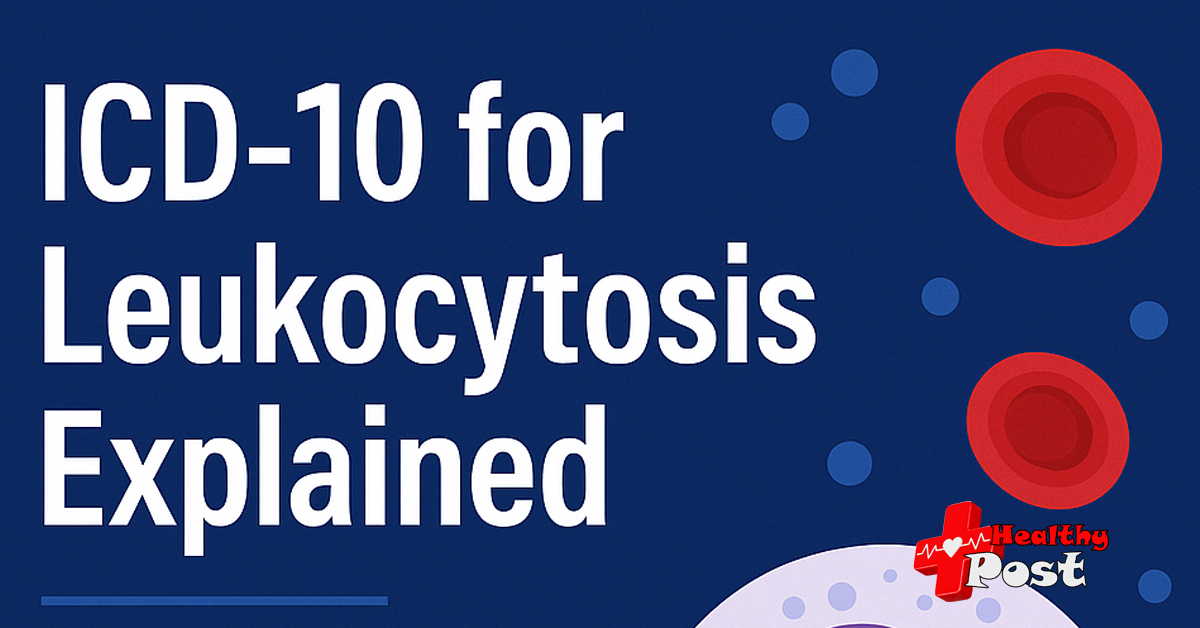
ICD 10 for Leukocytosis Explained: Symptoms, Causes, and Coding Updates
Leukocytosis is a condition with too many white blood cells in the blood. It can signal infection, stress, or other issues. Doctors use this count to find the cause and start the right treatment. Correct medical coding ensures clear communication between healthcare providers and insurance companies. It also helps with proper billing and record keeping. The ICD 10 for leukocytosis is a vital part of this process. It helps classify the condition clearly in medical records.
What You Will Learn in This Article
In this article, you will learn the meaning of the ICD 10 for leukocytosis. We’ll explain its symptoms and what causes this condition.
You will also get the latest updates on ICD 10 codes. These help medical staff use the correct terms and codes for billing and diagnosis.
We will break down everything in a simple, clear way. A table and infographic will help you understand how leukocytosis codes are used.
This guide is perfect for medical coders, students, and healthcare workers. It’s also helpful for anyone who wants to understand more about this blood condition.
Table: ICD 10 Code Summary for Leukocytosis
| Condition Type | ICD 10 Code | Description |
|---|---|---|
| Leukocytosis | D72.829 | Elevated white blood cells, NOS |
| Neutrophilia | D72.820 | High neutrophils (type of WBC) |
| Lymphocytosis | D72.810 | High lymphocytes (type of WBC) |
| Other abnormalities | D72.89 | Other specified white blood cell disorders |
What Is Leukocytosis?
Leukocytosis means having too many white blood cells (WBCs) in the blood. These cells help the body fight infection and disease.
White blood cells are a key part of the immune system. When their numbers go up, it usually means the body is reacting to something. This could be an infection, inflammation, stress, or even certain medications.
Why White Blood Cell Levels Matter
A normal white blood cell count keeps the body healthy. Too many WBCs can signal a health problem. It may point to a short-term issue like the flu or a serious condition like leukemia.
Doctors check white blood cell levels with a blood test. This helps them find out what is wrong and how to treat it.
The Importance of Accurate Diagnosis
An accurate diagnosis helps doctors choose the right treatment. If the cause of leukocytosis is not known, the wrong treatment may be used.
Correct diagnosis also ensures proper medical coding. The ICD 10 for leukocytosis helps healthcare workers label this condition correctly in records.
This is important for both treatment and billing. Accurate coding supports better patient care and avoids insurance claim problems.
ICD 10 for Leukocytosis: Understanding the Code
The ICD 10 for leukocytosis is a medical code used to classify this condition. ICD stands for International Classification of Diseases, 10th Revision. Doctors and coders use these codes to describe diseases and health conditions clearly.
The Exact ICD-10 Code for Leukocytosis
The specific ICD-10 code for leukocytosis is D72.829. This code stands for “Elevated white blood cell count, unspecified.”
It is used when a patient has high white blood cells, but the exact type is not yet clear. Other related codes may be used if the type is known, such as:
- D72.820 for Neutrophilia
- D72.810 for Lymphocytosis
Why This Code Matters in Healthcare
The ICD 10 for leukocytosis is essential for medical records and billing. It helps doctors, nurses, and medical coders speak the same language.
Using the right code ensures patients are billed correctly. It also helps insurance companies process claims faster.
Accurate coding supports research, care planning, and public health data tracking. It plays a key role in modern healthcare.
Symptoms of Leukocytosis
The symptoms of leukocytosis can vary depending on what is causing the high white blood cell count. Some people may have no symptoms at all, while others may feel very sick.
Common Signs Patients May Experience
- Fever or chills
- Fatigue or weakness
- Dizziness or lightheadedness
- Shortness of breath
- Unexplained bruising or bleeding
- Infections that come back often
- Swelling or pain in certain body parts
These symptoms often happen when the body is fighting an infection or dealing with inflammation.
How Symptoms Vary by Cause
Leukocytosis can have many causes. Each one can bring different symptoms:
- Infections: Fever, chills, and body aches
- Inflammation: Joint pain, swelling, or redness
- Stress or trauma: Rapid heart rate, anxiety, or high blood pressure
- Cancer (like leukemia): Weight loss, frequent infections, or bleeding
How Symptoms Help in Diagnosis
Doctors use symptoms, along with blood test results, to find the cause of leukocytosis.
Knowing the symptoms helps narrow down the diagnosis. For example, fever and sore throat may point to a bacterial infection.
An accurate diagnosis ensures the correct ICD 10 for leukocytosis is used in medical records. This helps with both treatment and insurance billing.
Causes of Leukocytosis
The ICD 10 for leukocytosis helps classify this condition, but understanding the causes is key to treatment. Leukocytosis can happen for many reasons, and each cause affects the body in different ways.
Infectious Causes
Infections are the most common cause of leukocytosis. When germs enter the body, white blood cells increase to fight them.
- Bacterial infections like pneumonia or strep throat
- Viral infections such as the flu or COVID-19
- Fungal infections in the lungs or skin
- Parasitic infections in rare cases
These infections can cause symptoms like fever, chills, or body pain. The rise in white blood cells is the body’s natural defense.
Inflammatory Causes
Inflammation can also lead to leukocytosis. This often happens with chronic illnesses or autoimmune diseases.
- Rheumatoid arthritis
- Lupus
- Inflammatory bowel disease (IBD)
These conditions cause the immune system to attack healthy tissues. This leads to swelling, pain, and high white blood cells.
Other Contributing Factors
Leukocytosis is not always due to illness. Some lifestyle and medical factors can also cause it:
- Physical or emotional stress
- Smoking
- Pregnancy
- Medications like steroids or lithium
- Bone marrow disorders such as leukemia
Doctors must look at the full health picture to find the cause. Knowing the reason helps them assign the correct ICD 10 for leukocytosis.
Diagnosis and Testing for Leukocytosis
Doctors use several tests to find the cause of leukocytosis. These tests check white blood cell levels and look for signs of infection or other problems.
Common Tests for Detecting Leukocytosis
- Complete Blood Count (CBC) – This is the main test to detect leukocytosis. It shows the number of white blood cells.
- White Blood Cell Differential – This test shows the types of white cells (like neutrophils or lymphocytes).
- Blood Smear – A sample is viewed under a microscope to look for abnormal cells.
- C-reactive Protein (CRP) – This test checks for inflammation in the body.
- Erythrocyte Sedimentation Rate (ESR) – Another marker of inflammation.
These tests help confirm the diagnosis and guide further steps.
Understanding Blood Count and Related Markers
The CBC shows if the white blood cell count is above normal. A normal range is usually 4,000 to 11,000 WBCs per microliter of blood.
If the count is higher, the ICD 10 for leukocytosis (D72.829) may be used.
The differential test helps identify the type of leukocytosis. For example:
- High neutrophils may suggest a bacterial infection.
- High lymphocytes can point to a viral infection.
- High eosinophils may indicate allergies or parasites.
When Additional Tests Are Needed
If the cause is not clear, more tests may be done. These may include:
- Bone marrow biopsy – To check for blood cancers.
- Imaging tests – Such as X-rays or CT scans to find infections or tumors.
- Urine or sputum tests – To detect hidden infections.
These tests help doctors make an accurate diagnosis and use the correct ICD 10 for leukocytosis in records.
Treatment Options for Leukocytosis
Treatment for leukocytosis depends on what is causing the high white blood cell count. Doctors focus on treating the root problem, not just the WBC levels.
The ICD 10 for leukocytosis helps identify the condition in medical records, but treatment plans vary from person to person.
Treating the Underlying Cause
Doctors first find the reason for leukocytosis. Once the cause is known, they choose the right treatment:
- Infections: Treated with antibiotics or antiviral medications
- Inflammation or autoimmune diseases: Treated with anti-inflammatory or immune-suppressing drugs
- Allergic reactions: Treated with antihistamines or steroids
- Blood cancers: May need chemotherapy or other advanced care
Lifestyle Changes and Medications
In some cases, lifestyle factors contribute to leukocytosis. Changes that may help include:
- Quitting smoking
- Managing stress through rest or therapy
- Staying hydrated and eating healthy
Doctors may also stop or adjust medications that raise WBC levels, such as steroids or lithium.
When No Treatment Is Needed
Not all cases of leukocytosis need treatment. Sometimes, it’s a short-term response to stress or mild illness.
In these cases, doctors may choose to monitor the patient over time. If the white blood cell count returns to normal, no action is needed.
Accurate diagnosis and proper use of the ICD 10 for leukocytosis ensure patients get the care they need—without unnecessary treatments.
Would you like a conclusion section to wrap up the article?
Importance of ICD 10 Coding for Leukocytosis
Accurate coding is a key part of modern healthcare. The ICD 10 for leukocytosis helps classify this condition in a clear and consistent way.
This code is used by doctors, hospitals, and insurance providers to keep track of diagnoses and treatments.
Role in Insurance and Billing
The ICD 10 code makes it easier to process insurance claims. It tells the insurer exactly what condition the patient has.
This helps speed up claim approvals and ensures that providers are paid on time.
Using the correct ICD 10 for leukocytosis (D72.829) avoids delays and reduces rejected claims.
Preventing Billing Errors
Incorrect or missing codes can lead to serious billing problems.
- Claims may be denied
- Patients may be overcharged
- Providers may face audits or fines
Accurate coding avoids these issues. It ensures the medical bill matches the actual diagnosis and treatment.
Supporting Medical Research and Data Tracking
ICD 10 codes also help in public health and medical research.
They are used to collect data on how common certain conditions are. This helps researchers find patterns and improve care.
For example, tracking how often the ICD 10 for leukocytosis is used can show trends in infection rates or immune diseases.
Correct coding supports better care, fewer errors, and stronger medical research.
Common Mistakes in ICD 10 Coding for Leukocytosis
Using the correct ICD 10 for leukocytosis is essential for accurate records and smooth billing. However, many coders and healthcare providers make avoidable mistakes.
Frequent Errors in Classification
Here are some common errors when coding leukocytosis:
- Using the wrong code (e.g., using infection-specific codes instead of D72.829)
- Missing a more specific code (e.g., using D72.829 when neutrophilia or lymphocytosis is known)
- Confusing leukocytosis with leukopenia (low white blood cell count)
- Failing to update the code after lab confirmation of the specific condition
- Skipping code entry when leukocytosis is noted but not officially documented
These errors can affect both treatment records and insurance claims.
Tips to Ensure Coding Accuracy
To avoid mistakes, follow these simple tips:
- Always review lab results before assigning a code
- Use the most specific ICD 10 code available based on clinical data
- Check documentation for updates or corrections from physicians
- Stay informed about current coding guidelines and updates
- Use coding software or tools to verify the correct entry
Impact of Mistakes on Reimbursement and Records
Incorrect use of the ICD 10 for leukocytosis can lead to denied claims or delayed payments. It may also:
- Cause confusion in patient records
- Lead to unnecessary treatments or repeat tests
- Damage provider credibility during audits
- Affect public health data and research accuracy
Accurate coding helps maintain trust, improves care, and ensures correct payment.
Latest Updates in ICD 10 for Leukocytosis
The ICD 10 for leukocytosis has seen updates in recent years to improve clarity and precision in diagnosis coding. These changes help healthcare providers and coders assign the most accurate code for elevated white blood cell counts.
Recent Coding Revisions
ICD-10 updates now include more specific codes under the D72 category. For example:
- D72.829 – Elevated white blood cell count, unspecified (commonly used when the cause is not yet clear)
- D72.810 – Lymphocytosis (increased lymphocytes)
- D72.820 – Neutrophilia (increased neutrophils)
These codes help classify leukocytosis by cell type, improving diagnosis documentation and treatment accuracy.
How Updates Improve Medical Tracking
Using updated ICD 10 codes helps healthcare systems:
- Track disease trends more precisely
- Identify outbreaks or health risks sooner
- Improve patient care by tailoring treatments
- Strengthen public health reporting and analysis
The ICD 10 for leukocytosis and its subcategories also make research and data sharing more effective.
Tips for Staying Updated on ICD Changes
To avoid coding errors, it’s important to stay current with changes. Here are some simple ways to keep up:
- Subscribe to official updates from the World Health Organization (WHO) or CMS
- Use updated coding manuals or software each year
- Attend webinars or training sessions offered by AHIMA or AAPC
- Check employer or facility bulletins for internal policy changes
- Join professional forums to learn from other coders and healthcare workers
Keeping up with the latest changes ensures the correct use of the ICD 10 for leukocytosis, improves billing accuracy, and supports better patient care.
Conclusion
In this article, we explored the significance of ICD 10 for leukocytosis and how it plays a vital role in medical diagnosis, treatment, and billing. We discussed the common symptoms, causes, and diagnostic tests associated with leukocytosis. We also highlighted the importance of accurate coding for proper medical records, effective billing, and improved patient care.
The ICD 10 for leukocytosis code (D72.829) is essential for healthcare professionals to document this condition accurately. It helps ensure that patients receive the correct diagnosis and treatment, while also preventing billing errors and delays in insurance claims.
As medical coding continues to evolve, staying updated with the latest revisions is crucial. Accurate coding not only supports effective care but also contributes to better healthcare tracking and research.
We encourage all healthcare professionals to apply the correct ICD 10 for leukocytosis codes in their practice. Doing so ensures that patients are treated appropriately, records are kept accurate, and the healthcare system runs smoothly.
By staying informed and committed to accuracy, we can continue to improve patient outcomes and the efficiency of healthcare services.

